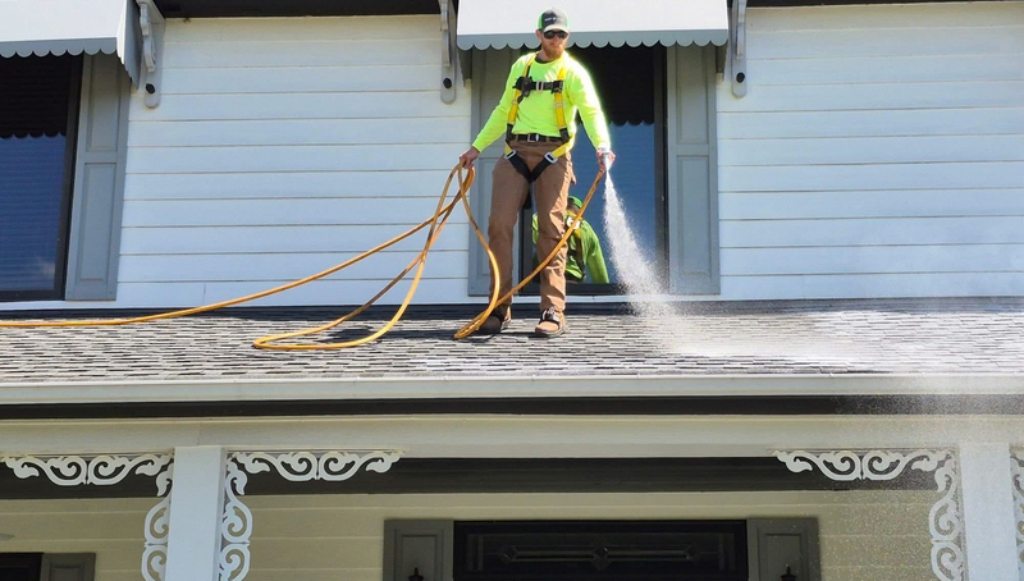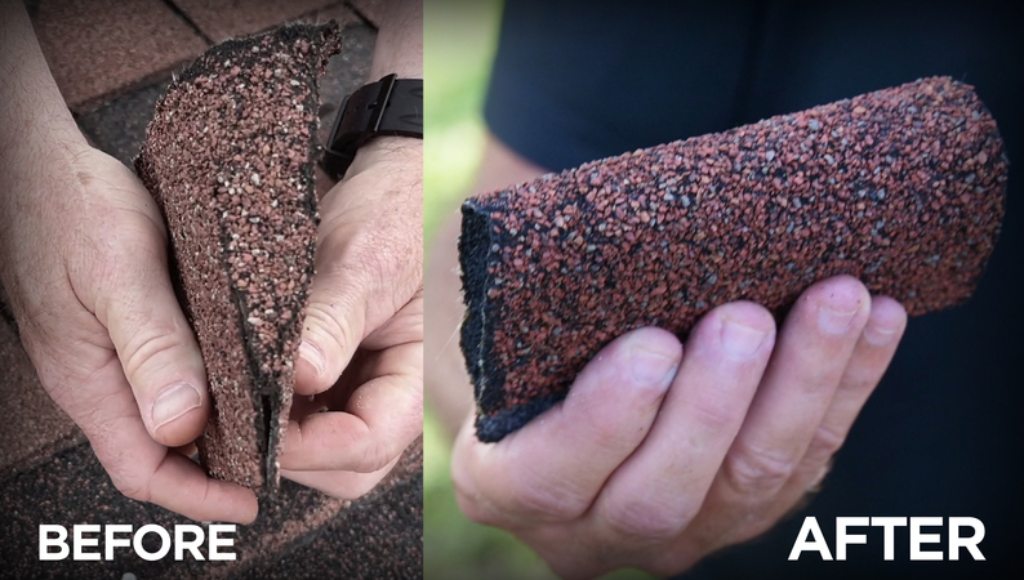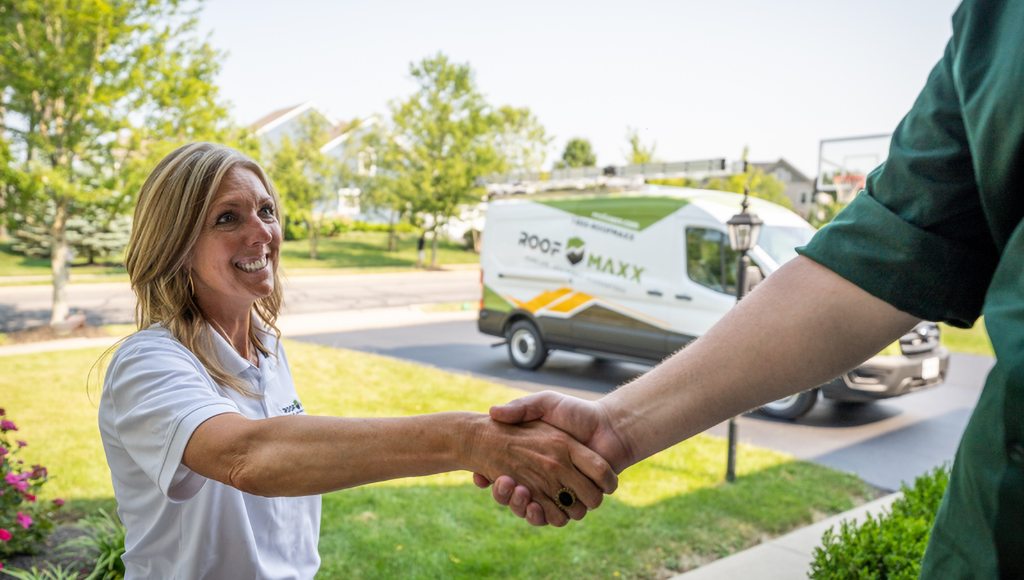Asphalt shingles take a lot of abuse from the elements—and over time, they can dry out and start to become brittle. That’s when you’ll typically start to lose shingles to windshear and experience granule loss or cracking.
When that happens, it’s time to take action.
No one wants to pay for early roof replacement if they don’t have to, which is why some homeowners reach for acrylic and polyurethane roof coatings. But are they really as safe and effective as soy-based penetrants like Roof Maxx, and how are these products different?
Below, we’ll compare these options and show you the science behind Roof Maxx so you can see why we believe it’s the best option for asphalt shingle roofs. Take a look, then see our treatment in action for yourself.

Roof Maxx uses its own proprietary formula—but other, more generic roofing products tend to have several core ingredients in common. Here’s what you’re likely to find in each one:
These products all make many claims, but Roof Maxx is backed by scientific testing and proven to produce results on asphalt shingles that are generally in good condition.

Roof Maxx is a soybean oil roof solution, and it’s one of the most environmentally-friendly penetrants on the market. We asked Ohio State University to independently evaluate how it affects sustainability and the environment. They found that applying Roof Maxx to just one house helps avoid:
Because Roof Maxx is made from soybeans, it penetrates into your shingles and breaks down naturally over time. It won’t pollute the soil, leach into the water table, or leave behind a sticky residue that traps pollinating insects or birds.
Read More: Is Roof Maxx Really Safe?
Fully synthetic coatings are inherently harder on the environment because they don’t biodegrade as easily. Think about the difference between throwing away plastic packaging and compost—one breaks down fast, while the other persists for hundreds of years.
The environmental impacts mostly come down to two factors: plastics and harmful chemicals called Volatile Organic Compounds (VOCs). Here’s what you need to know about them:
The microplastics issue is so serious now that researchers are starting to find particles in the human body, and they don’t fully understand how they impact our health. There is evidence to show that certain plastics can be carcinogenic or possibly lead to cognitive decline.

Soy-based penetrants like Roof Maxx aren’t a coating; they’re a penetrant. That means the solution works by being absorbed into your asphalt shingles, where it replaces the petrochemical oils they naturally lose over time.
This won’t reverse damage like cracks or missing granules, but it will make your shingles flexible and durable again—which helps prevent further granule loss and helps them resist the elements more effectively.
With SMEE products, the condition of your roof and the timing of the application itself can affect how long they last and how much value you get from them. We can’t speak for other products, but here’s what you can expect from Roof Maxx:
Soy-based products aren’t considered a fire risk, won’t void your warranty, and may even improve the look of your roof, which is a nice added bonus.
Acrylic and polyurethane coatings don’t soak into your shingles, they sit on the surface like a film or membrane, creating a barrier against the elements. This can temporarily mask or even slow damage like cracks or granule loss, but it’s a band-aid at best.
Here’s what to expect from acrylic coatings:
And here’s what to expect from polyurethane coatings:
The Asphalt Roofing Manufacturers Association (ARMA) recommends against applying coatings of any kind to your asphalt shingle roof. They believe there is “limited available documentation” to prove the benefits to homeowners after the fact.
Read More: Should You Replace or Restore Your Roof?

The total cost for each treatment will vary widely depending on the size, complexity, and condition of your roof. We recommend speaking with one of our dealers if you want the most accurate quote, but here’s what you can expect to pay:
Don’t forget that all coatings and treatments come with additional prep and labor costs that aren’t usually included. Roof Maxx can optionally provide a roof tune-up before treatment to help ensure you get maximum results from the solution.
| Feature | Soy-Based Penetrants | Acrylic Coatings | Polyurethane Coatings |
|---|---|---|---|
| Average Cost | ~$1.40 to $2.75 per sq ft¹ | ~$0.50 to $3.00 per sq ft | ~$1.50 to $4.00 per sq ft |
| Reapplication | Every 5 years (up to 3x) | Every 2 to 5 years | Every 5 to 10 years |
| Added Lifespan | Up to 15 years total | Typically 2 to 10 years | 10 to 15 years |
| How it Works | Absorbs into shingles | Sits on surface as a film | Sits on surface; requires resin and hardener mixing |
| Restores Flexibility? | Yes | No | No |
| Impact on the Environment | Biodegradable, plant-based, low waste | Synthetic, may release microplastics and VOCs | Synthetic, high solvent load and landfill impact |
| Warranty Risk | Unlikely to void roof warranty | May void warranty depending on manufacturer | Often voids manufacturer warranty |

Acrylic and polyurethane coatings can seem sensible and affordable at first glance, but they don’t do anything to restore the flexibility of asphalt shingles. While they might seem like a good option, they just aren’t as effective on asphalt shingle roofs and may even leave you with a bigger mess on your hands.
Soy-based treatments like Roof Maxx penetrate deep into each shingle to restore lost oils, making them supple again—and at the end of the day, it’s flexibility that counts. Find a dealer in your area now to get a free, no-obligation quote.
With our five-year, transferable warranty, you’ll enjoy the peace of mind that your roof and entire home are protected.